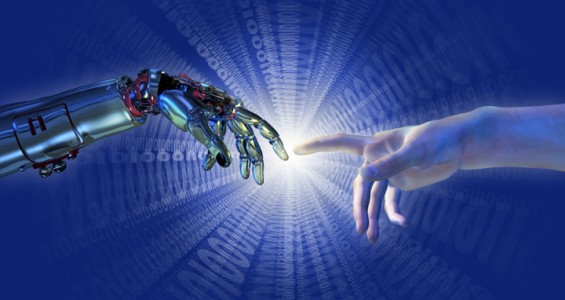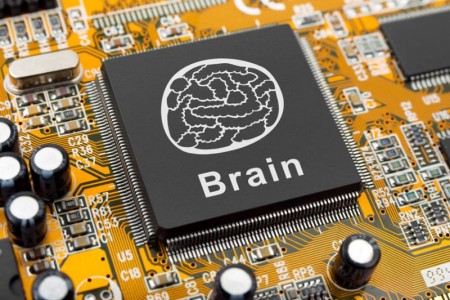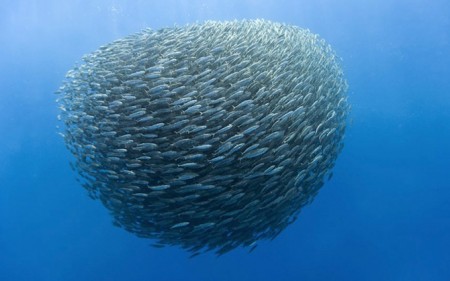March 9, 2016 – In Our Own Image: Will Artificial Intelligence Save or Destroy Us? is the title of George Zarkadakis‘s book on artificial intelligence (AI). It’s a journey that traces the origins of human intelligence from the evolution of consciousness to the origin of language, art and our love of metaphor. Zarkadakis is a great story teller and he emphasizes story telling as a unique human characteristic. No AI created today can match our capacity to do this.
Zarkadakis holds a PhD in AI. In exploring the sophisticated computers of today such as IBM’s Watson and its predecessor Deep Blue, he distinguishes human intelligence from that of the machine. We humans are more than our brains.
What do I mean by that?
The brain may be the source of human intelligence but it is intimately interconnected with the feedback mechanism that is our body. Compare that to hardware and software. Computers separate the two. Humans integrate the two. We are not the sum of our programming.
Will AI surpass us one day?
When Elon Musk and Stephen Hawking recently raised the specter of a malevolent future AI with the former dedicating some of his millions to found an institute to ensure this never happens, he was repeating a pattern seen in past human revolutions. The Industrial Revolution of the 18th century led to a backlash against machines in many parts of the world. But today we are through the Internet and sophisticated computing technology experiencing a second Industrial Revolution. Hence a push back.
But as long as computers distinctly separate hardware from software intelligence Zarkadakis believes they will never become conscious machines. They certainly will exhibit AI but not free will. He describes them as mindless agents capable of powerful computational processes. In other words they can handle metadata and parse it. They can be repositories of collective human wisdom, our science, our intelligence, but that’s not the same as consciousness.
Zarkadakis, however, has a caveat. It is neuromorphic computing.
What is neuromorphic computing?
This is computer technology that is capable of learning because it mimics neuro-biological processes through electronic circuits. Software and hardware are no longer separated. I have written about neuromorphic chips, memristors, and the Human Brain Project in the past. This is technology capable of duplicating our brains and our capacity to learn. A neuromorphic AI would start it life like a human baby responding to external stimuli. It would learn by observing. It would grasp the fundamentals of language. And ultimately it would have endless capacity to absorb information and observe us. This AI will likely surpass us in time but we are not close to realizing the technology as of yet.
Another Zarkadakis caveat is swarm technology.
In the natural world we can see evidence of swarm intelligence in the behavior of termites, ants, bees, flocks of birds and schools of fish. If we humans build the equivalent to an ant and ant brain a single unit will be perceived as non threatening. Make it self replicating and capable of interconnecting with other units and we would have another story. As Zarkadakis describes it we would see intelligence of the swarm emerge.
In crowdsourcing where problems posted online get the benefit of input from millions of human brains tackling the challenge we see the intelligence of the swarm. Whether it’s finding new ways to fold proteins, or solving complex mathematical problems, the intelligence of the swarm can be significantly greater than any one individual.
Machines capable of swarm AI , although not conscious, may pose a collective threat to humanity once the genie is let out of the lamp. Michael Crichton‘s science fiction novel, Prey, paints such a picture.
So are we doomed to create an AI that will surpass and subjugate us?
More than likely not because we have the means to put brakes on AI research, the kind that Musk and Hawking want to see enforced.
But there is a more likely scenario and that is the integration of AI with human intelligence where we facilitate the former’s capability to help solve human problems. Using crowdsourcing AI is already demonstrating benefits. Zardakis talks about the Galaxy Zoo project where 150,000 human volunteers classified 50 million galaxies in its first year of operation by using computers and database software to compile the information. Machines don’t have to be conscious to display AI. It’s intelligence but it is of a different kind than ours.
Could we one day merge human and machine, what Ray Kurzweil calls the singularity? Zarkadakis believes we can develop technologies to better communicate with AI partners, exploring symbiosis of human and computer minds. But should that computer mind evolve consciousness? That is the outstanding and problematic question.










